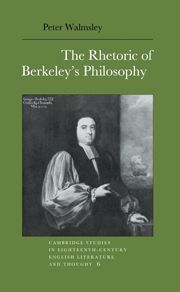Book contents
- Frontmatter
- Contents
- Acknowledgments
- Note to the reader
- Introduction
- PART I THE PRINCIPLES OF HUMAN KNOWLEDGE
- PART II THREE DIALOGUES BETWEEN HYLAS AND PHILONOUS
- PART III ALCIPHRON
- PART IV SIRIS
- 11 The rude essay
- 12 The method of inductive analogy
- 13 The hoary maxims of the ancients
- Conclusion
- Select bibliography
- Index
13 - The hoary maxims of the ancients
Published online by Cambridge University Press: 21 August 2009
- Frontmatter
- Contents
- Acknowledgments
- Note to the reader
- Introduction
- PART I THE PRINCIPLES OF HUMAN KNOWLEDGE
- PART II THREE DIALOGUES BETWEEN HYLAS AND PHILONOUS
- PART III ALCIPHRON
- PART IV SIRIS
- 11 The rude essay
- 12 The method of inductive analogy
- 13 The hoary maxims of the ancients
- Conclusion
- Select bibliography
- Index
Summary
One of the most disconcerting features of Siris's rhetoric is its frequent citation of the works of other philosophers. At first such authorities are few and scattered. In the course of his initial botanical discussion Berkeley only occasionally invokes the opinions of such experts as Theophrastus, Evelyn and Ray. These authorities do not seem inappropriate because, like Berkeley, they are men of science with first-hand experience of the subject. But as Siris moves towards metaphysics and theology, the authorities come thicker and faster until the discourse virtually proceeds in terms of the opinions and writings of other thinkers. Siris becomes like Burton's Anatomy of Melancholy, a cento or a patchwork of learned opinions. That Berkeley should adopt so cumbersome and antiquated a mode of exposition is disturbing. It moved G. J. Warnock to dismiss Siris as ‘Gothic’, and even a sympathetic reader like Jessop longs for the ‘clean, stripped, athletic pages of the Principles’ (V. 18). Berkeley's reliance on the argument from authority is stranger still in that it had been loudly and almost universally denounced in the seventeenth century as a feature of outmoded, scholastic learning. The most vociferous critics had been the apologists for the new natural philosophy. One of the first critics of Siris, the physician James Jurin, derides Berkeley for borrowing two-thirds of his material from other authors: ‘the Ipse dixit of your Lordship will not, with men of Science, stand against Experience and well-founded Knowledge’. While Bacon had argued that scholastic science was too speculative and dogmatic, Thomas Browne showed in his Pseudodoxia Epidemica that the little empirical evidence it had to work with was inaccurate.
- Type
- Chapter
- Information
- The Rhetoric of Berkeley's Philosophy , pp. 173 - 181Publisher: Cambridge University PressPrint publication year: 1990

